Although our governor had not yet closed schools, when I stepped onto the buses the afternoon of March 13, 2020, to send off my students, I knew it would be the last time I would see them for a while. I mourned the loss of the growth trajectory we were making as a school and the impact learning remotely might have on our students. We have now brought back students to learn in person, but it was a lonely and isolated time of constant pivoting for educators, families, and children when we were teaching remotely. With this in mind, I reflected on what has sustained our staff and how our collaboration to maintain our school culture during the last year rested on our beliefs of belonging, significance, and fun through our weekly schoolwide Morning Meetings.
Schoolwide Morning Meetings
Whether at the building or classroom level, intentionality is the epitome of effective decision-making because it aligns beliefs and practices. When I started as principal, we implemented monthly schoolwide Morning Meetings as a way to come together as a community and to celebrate our sense of belonging and fun as a school. Grade-level teams and students took turns leading the meetings using the four components of greeting, share, activity, and message. Over the years we have incorporated chants and energizers that reflect pieces of our vision, such as a character trait and a book feature. These became important pieces of our traditions and culture.
Logistics of Transferring Into a Virtual Platform
Maintaining school culture was a key goal of mine. To get schoolwide Morning Meetings off the ground logistically, we approached it in a pragmatic way, asking, “What will be a consistent structure for students?” This consistent structure was defined by both access and predictability.
Fridays were asynchronous learning, but students were still to participate in a daily Morning Meeting. This seemed like the perfect time to schedule it because of the established predictability in students’ virtual schedule, and for this reason, we switched from a monthly schoolwide Morning Meeting to a weekly one. It was also a way for me, as principal, to take care of my staff by lessening their load and stepping into the role of the lead learner.
A school Zoom link was established for easy access to the daily live morning announcements and Morning Meeting. Students’ daily schedules contained a button with a link to our morning announcements. On Friday, this same button would link to the schoolwide Morning Meeting. We found ways for children to participate by starting with an open chat and off-mute time, calling students by name to recognize their participation, and using the chat box for shares.
Morning Meeting Components
Implementing Morning Meeting components over Zoom involved creativity and flexibility. In addition, we did not adhere to the specific order of the Morning Meeting components. When planning the components, we asked, “What is my theme for the schoolwide Morning Meeting?” and “What is the specific purpose of each component connected to that theme?”
Message
While typically done at the end of Morning Meetings, we opened with our message to provide focus for the school community. The message presented a perfect opportunity for reinforcing schoolwide expectations, using envisioning language, and posting our school word-of-the-week. I also used it as a way to introduce our co-hosts for the meeting.
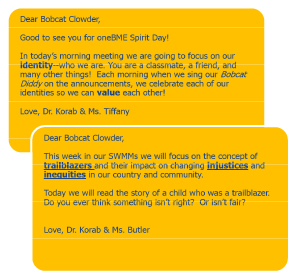
Greeting
The greeting began by first welcoming each grade level before then moving to family, staff, and our entire school community. The purpose for this was to set a positive tone for our time together and ensure all members of the community were included. Whether in person or virtual, we wanted to make sure we did a greeting even our youngest students could participate in. In the virtual platform, the Camera On/Off game worked well in structuring thematic greetings. Chants were also successful (for example, “We’ve got spirit yes we do!”) because their short and rhythmic nature is catchy and easy for students to say on their own. One highlight was a call and response with all students unmuted, utilizing Interactive Modeling, visuals, and anticipated lag-time.
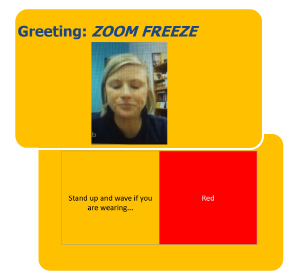
Share
Because the size of our group ranged from 225–300 Zoom users at once, the format of our share varied greatly from what it looks like in a classroom setting. However, we stuck to our goal of connecting over an important event or theme. For example:
Read-alouds. The book title was connected to the theme of the Morning Meeting. Reading and listening to a book together as a school community affirmed our values of being lifelong readers.

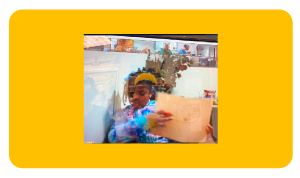
Gallery walk. Students drew or wrote a response to a question related to the theme of our Morning Meeting. A few students were selected to spotlight.
Open-ended questions. Students used their Zoom hand and I opened the chat feature to “host only” so students could share their responses or ask questions of our guest speaker. Having a variety of ways for students to respond increased participation.
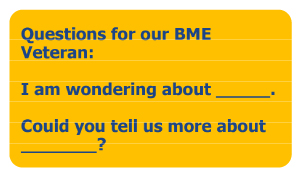
Activity
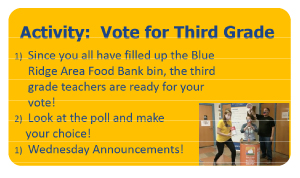
Activities took a variety of forms, including songs, doodle poll votes, and the cognitive routine of Notice and Wonder based on a picture that connected to the theme.
Other Elements
The list that follows are elements we have in our daily live announcement that we also used in our schoolwide Morning Meetings each week to establish a sense of community with common songs and chants.
- Energizers
- Bobcat Boogie, a chant developed by our music teacher
- Bobcat Ditty, composed by staff during preservice week, about valuing each individual
- Dancing to fun and age-appropriate songs, like our school favorite, “The Avocado Song” by Alton Eugene
- Academic and social acknowledgments, including library book Check Out Champions and character trait shout-outs
- Jokes (typically submitted by students)
- Spirit Day Dress Up to promote continual school spirit, connect with our theme, and allow all students to participate. For example, on Color Day, each grade level was assigned a color to wear. In addition, we had a monthly school spirit day when each child could wear school colors.
- New this year are elements of reflection, which connect with the social-emotional competence of self-awareness. In our first schoolwide Morning Meeting we read The Pigeon Has to Go to School by Mo Willems and used his changing feelings about school to create our reflection stems. Each week students shared out something they were proud of, using the Zoom hand or chat. Together we celebrated academic, social, and play-based accomplishments.
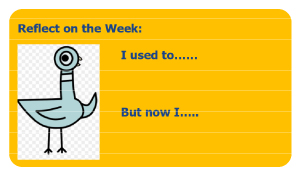
Collaboration for Deeper Meaning and Connection
Just as the purpose of the first six weeks of school is to create a safe, inviting, and inclusive climate, we wanted our schoolwide Morning Meetings to accomplish the same. For the first three to four weeks our meetings centered on “Fri-YAY Fun” because we wanted to reconnect virtually and teach inclusive and easy ways to participate that would sustain us for months. While eventually we would move to more in-depth themes, it was an intentional decision to keep Morning Meetings fun.
While classroom Morning Meetings connect academic content, virtual schoolwide ones were an opportunity to intentionally align, affirm, and integrate our work as a school. Two influential books that impacted academic content in schoolwide Morning Meetings were Natalie Wexler’s The Knowledge Gap and Gholdy Muhammad’s Cultivating Genius. As we moved through the first semester, our academic content themes connected to identity and change. We mapped out thematic essential questions that gave the month a focus (for example, “How do trailblazers positively impact inequities in our society?”). The schoolwide Morning Meetings became a structure for valuing differences as part of our school
culture.
| Theme Examples | Spirit Day Dress-Up Examples | Connected Components Examples | Special Features Examples |
|---|---|---|---|
| Parades | Parade Spirit: Wear school colors | Greeting: Parade wave Share: Macy’s Thanksgiving Day Parade | Grade-level share: Balloons Over Broadway read-aloud and virtual share of second grade floats |
| Math | Wear a number | Greeting: “My number is” Activity: Math Game | Students received family games to play at home together |
| Veterans Day | Red, white, and blue | Notice and Wonder cognitive routine | Co-host was a teacher who was a veteran. He participated in a panel. |
| Trailblazers: Who has helped paved the way for others? | Grade-level color | Greeting: Courageous greeting Share: Read-alouds from trailblazers in various areas Activity: Notice and Wonder cognitive routine | Read-aloud from a former student who was a part of integrating Charlottesville City Schools |
Going On Together
This pandemic has confirmed for children and adults in schools the need to belong and know they are important. As we finish the current school year and look forward to 2021–2022, it is important to go through it together.
“Together” means our professional colleagues. As we continue into 2021, we will be facing the hardest challenges of our careers: public education in the post-pandemic era, where opportunity gaps have widened, trauma has increased, and budgets are reduced. I could not have gotten to this point without my division elementary principals. Together we talk, troubleshoot, and laugh each day.
Since entering administration, I have connected to the practitioner-focused strategies of Responsive Classroom because they are rooted in principles that align with culturally responsive teaching to achieve academic, social, and emotional growth. As we recover together, I want to learn from other educators and schools that are committed to creating a sense of belonging, significance, and fun while working toward emotional and academic growth. As school leaders, we have a sense of duty to collaborate for the benefit of all our students.
“Together” also means our school community: students, families, and staff. Our last schoolwide Morning Meeting of 2020 was a celebration of the values we share as a school community through a virtual elementary music concert. For so many of us experienced educators, the unique challenges of 2020 have left us feeling like a novice many times over. Schoolwide Morning Meetings have maintained our relationships with students, families, and staff, and they have reaffirmed what we believe in most—each other—and what we can accomplish when we work together. Schoolwide Morning Meetings have not only addressed the social and emotional needs of students, they have also benefited the social and emotional health of the adults.
“Together” means us as educators. We are as strong as the knowledge and creativity that exists among us, connected by the love of what happens for students. Throughout this year of planning virtual Morning Meetings, I sought ideas from my staff and collaborated with them. As we finish this school year, our specials team has now taken the reins of planning and implementing our schoolwide Morning Meetings. I am continually humbled by the amazing colleagues I work with and their daily impact on my practice. This month, as we celebrate teachers and educators, let’s commit to moving forward together.
Recommended Readings
- Hammond, Z. L. (2015). Culturally responsive teaching and the brain: Promoting authentic engagement and rigor among culturally and linguistically diverse students. Corwin.
- Kriete, R. & Davis, C. (2014). The morning meeting book, 3rd edition. Center for Responsive Schools.
- Muhammad, G. (2020). Cultivating genius: An equity framework for culturally and historically responsive legacy. Scholastic Teaching Resources.
- Responsive Classroom. (2015). The first six weeks of school, 2nd edition. Center for Responsive Schools.
- Responsive Classroom. (2016). The joyful classroom: Practical ways to engage and challenge elementary students. Center for Responsive Schools.
- Sprenger, M. (2020). Social-emotional learning and the brain: Strategies to help your students thrive. ASCD.
- Wexler, N. (2019). The knowledge gap: The hidden cause of America’s broken education system—and how to fix it. Avery.
